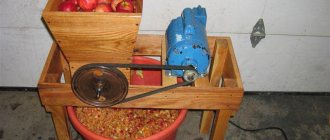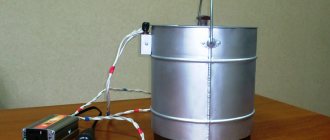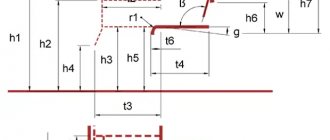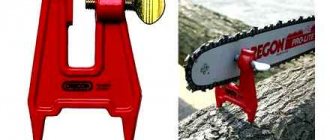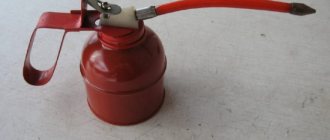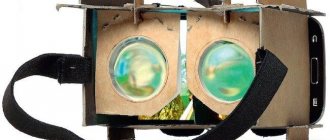Modern juicers cost a lot of money, and besides, they don’t work that well. Therefore, I decided to make a juicer with my own hands, better, simpler and, most importantly, cheaper.
For a homemade juice press you will need:
- 40mm plywood. You can glue several sheets of plywood with special wood glue.
- Good paint for interior surfaces
- Bottle jack, lifting capacity 4 tons
- 10mm threaded stud
- Flange or steel plate for press
- Thermoplastic
- Stainless steel sheet
- Primer spray
- Wood glue.
Required tools:
- Saw. Any will do. Jigsaw, table saw, band saw or regular hand saw.
- Cordless drill.
- Clamps
Additional tools for screw squeezer:
- Countersink
- Grinder
- Threading tools
Simple tips for your safety:
- Keep your hands away from anything that moves
- Wear safety shoes
- Wear safety glasses
DIY apple juicer
As a rule, winemakers prefer pressing units because during operation they do not heat the pulp and do not crush the seeds.
What you will need
To independently assemble a classic press, it is not necessary to use special drawings and a welding machine. The structure can be made of wood using conventional tools and fasteners, namely:
- hacksaw for metal or wood;
- hammer;
- Screwdriver Set;
- bolts, nuts, self-tapping screws;
- pliers.
Press components:
- boards, wooden blocks or slats;
- stainless steel sheet;
- barrel or tank;
- valve;
- piston-bending;
- metal channel.
It is desirable that the wooden elements be made of oak, beech or birch, since due to their biological activity, conifers change the taste of the sap.
Drainage gratings should not be made of chipboard, since dust containing phenol-formaldehyde adhesive will enter the finished product.
From an activator type machine
A centrifugal juicer can also be made from an activator-type washing machine. The activator and shaft are removed from the bottom of the tank, and a shaft of the required diameter is installed. Three knives are installed on the shaft thread with nuts at an angle of 60 degrees. The drain hole closes. A stainless steel mesh with a mesh size of approximately 1.5 mm is placed on the wall of the centrifuge with an overlap of 40-50 mm. A complete rubber cap, plugged with a stopper, is placed on the bottom. Everything is washed with baking soda. The timer relay is turned off or its toggle switch is jammed.
Several apples are dropped into the tank onto moving knives. The fruits are crushed for 20-30 minutes. At a time, transfer no more than 3 liters of the resulting puree into the centrifuge so that it does not spill out. After 2-3 minutes, the mesh containing the waste is removed.
The assembled apparatus prepares 10-12 liters of juice with pulp per hour and works with juicy fruits. To remove sediment, the juice is allowed to settle and then passed through cheesecloth.
Advantages of a homemade juicer
If you have an old unused washing machine, automatic or activator, you can turn it into a useful device for extracting juice. The idea is to install a grater inside the machine. The raw material is poured through a large hole, after which it is crushed and the juice is extracted. The advantage of this design is the ability to make juice in large volumes, which most household juicers cannot provide.
In addition, the homemade device has a much larger capacity for loading raw materials. Equipping such a juicer with a powerful motor will allow you to get about 20 liters of juice per hour. This indicator is quite enough to process apples from your own garden and also help your neighbor.
Operating principle and types
All presses for squeezing juice from various berries and fruits can be divided into four main types:
- mechanical devices;
- hydraulic presses;
- electrohydraulic models;
- pneumatic type devices.
The most common, due to its low cost and simplicity of design, is a manual mechanical press. One of the main elements of its design is a perforated basket, into which crushed fruits (pulp) or berries are placed to extract juice. Fruits and berries are squeezed in such a device using a piston, the lowering of which (and the creation of the required pressure) is carried out by rotating the handle that drives the screw mechanism of the press. The juice formed during the pressure of the piston flows through the holes in the basket into a special tray, from where it is then poured into another container.
Manual press device for squeezing juice
To make a basket into which the raw materials for squeezing the juice are loaded, stainless steel sheets or hardwood (for example, beech) can be used. In the second case, the design of such a basket is a drainage grid consisting of two equal parts connected to each other by metal hoops.
A modernized and, accordingly, more efficient version of the manual device is a hydraulic press, which can be used to extract juice from apples and berries. Instead of a perforated container, the design of such a press uses several drainage frames made of hard wood. The crushed raw materials from which it is necessary to obtain juice are placed in fabric bags and placed between such frames, on which significant pressure (1–5 tons) is applied from above, created by a manual hydraulic jack. Using such a squeezing mechanism, you can obtain up to 70% of the juice from the total mass of the processed crop.
Press with hydraulic jack
A hydraulic press does not necessarily involve the use of a jack as a mechanism that creates the required pressure. Thus, in one of the designs of such presses, this mechanism uses an elastic barrel-membrane, which expands under the influence of water supplied to it under a pressure of 1.5–2 atm from a regular water supply network. Expanding, such a press membrane acts on fruits and berries placed in a perforated basket, squeezing out juice from them, which flows through holes in the walls of the basket into a storage tray.
A pneumatic press for squeezing juice also works according to the principle described above. The only difference is that the expansion of the membrane barrel, also present in its design, occurs not under the influence of the water filling it, but under the pressure of compressed air supplied from the compressor.
Since certain types of raw materials from which juice must be extracted are loaded into presses in crushed form, it is necessary to mention devices that help bring it into this state. The design of the simplest grinder is a steel drum, the walls of which are made in the form of a grater. Such a drum, which turns the raw materials loaded into it into fine crumbs, is placed in a casing with a loading neck. This simple and effective mechanism is activated by rotating a special handle. There are also more efficient and productive models of such units that are driven by an electric motor.
An inexpensive electric chopper works well for processing several buckets of apples.
If we talk about the productivity of mechanical presses for squeezing juice, it is quite small and can be in the range of 10–30 l/hour. However, this performance is quite sufficient for devices used for domestic purposes.
In order to increase the percentage of juice yield from squeezed fruits and berries, as well as improve its quality, two methods are used:
- raw materials are loaded into presses in fabric bags that act as filters;
- The juice is squeezed out using drainage grates made of wood or using stainless steel “pancakes”.
The use of drainage grates or “pancakes” ensures that juice is squeezed not only from the upper and lower parts, but also from the middle part of the compressed volume. The bags, as mentioned above, act as filters and allow you to immediately clear the pulp from the squeezed juice.
Squeezing technology using lattices and bags is often used in the manufacture of homemade wood presses
In cases where the productivity of a hand press for obtaining juice is not enough, electrically driven devices are used. An electric drive can be seen in a screw press for squeezing juice and in screw-type units that operate on the principle of a conventional meat grinder. In the first case, the press drive is a pair of “electric motor – hydraulic jack”.
In screw presses, which are structurally reminiscent of a conventional meat grinder, the drive electric motor is directly connected to the working element - the screw. This press is used for squeezing grapes; it is also an excellent press for fruits, berries and squeezing juice from tomatoes. It works according to the following principle: the loaded raw material is crushed by means of a screw and pressed through a sieve that has a conical shape. This form of the sieve allows not only high-quality extraction of juice, but also the removal of seeds. It should be borne in mind that grape or any other juice obtained from such a press has a large amount of pulp.
Industrial screw press is designed to produce large quantities of juice or oil in a short period of time
Prices for serial models of juice presses depend on several factors:
- loading basket volume;
- device type;
- material of manufacture;
- press productivity in terms of juice obtained per unit of time.
Naturally, the cheapest option is a small-capacity home press operating on a screw principle. The cost of a hydraulic juicer is slightly higher. Next in the price category is a press juicer for processing apples and other raw materials, operating using compressed air. The most expensive ones on the market today are membrane-type hydraulic presses.
What materials will be needed
To make a standard press yourself, you do not need special skills or drawings. Anyone can measure, saw off a strip, hammer a nail or tighten a nut if desired. It is not necessary to own a welding machine; any design can be reproduced in wood using ordinary garden tools.
Homemade wooden apple press
To make a home press from tools, you will need a hacksaw for wood and metal (or a grinder), a welding machine, screwdrivers, pliers, and a hammer. As for materials, the following are mainly used:
- metal channel;
- wooden blocks, slats, boards;
- self-tapping screws, bolts and nuts;
- tank or barrel, stainless steel sheet;
- bench screw and nut, valve, threaded rod or jack - depending on the chosen design;
- durable fabric with good drainage properties for apple bags: calico, cotton, jute burlap, linen.
It is better to make wooden elements from oak, birch or beech, since materials from biologically active tree species (spruce, pine) can change the taste of the juice. Under no circumstances should drainage grates be made from chipboard: fine dust impregnated with phenol-formaldehyde glue will get into the product.
Worm gear or hydraulic jack: what to choose?
The screw (worm) mechanism in the press is implemented in the form of a large screw (threaded axis) with a nut or a mechanical jack. The latter option is much simpler - you can buy it at a spare parts store or take it out of the trunk of a car; you don’t need to look for, adjust, grind or weld anything.
Designs based on a hydraulic jack are much more productive (force from 1t) than mechanical ones, and require a minimum of human labor. Hydraulic bottle jacks make it possible to squeeze juice quickly and in large volumes. They fit comfortably into any design.
Bottle Hydraulic Jack
How to care for your home crusher
Caring for equipment is a prerequisite for its operation. Only with high-quality and careful care will household appliances serve with maximum functionality for a long time.
Juicers are no exception, because the remaining pulp of fruits and vegetables will become a huge breeding ground for bacteria and mold. In addition, the cake forms a coating on the body, contributing to the destruction of parts.
When caring for your home crusher, you should adhere to the following principles:
- Disassembling the device after use.
- Thorough rinsing and cleaning.
- Drying parts.
- Storage unassembled in a specially designated place.

